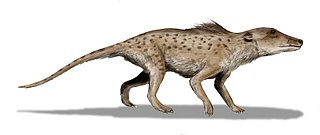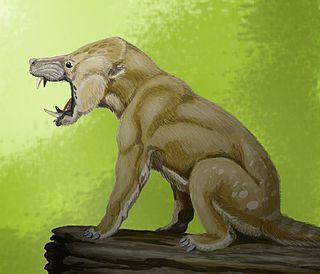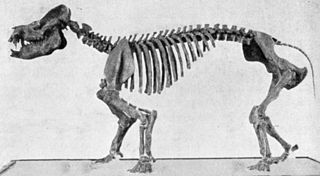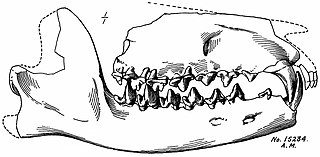
Rodhocetus is an extinct genus of protocetid early whale known from the Lutetian of Pakistan. The best-known protocetid, Rodhocetus is known from two partial skeletons that taken together give a complete image of an Eocene whale that had short limbs with long hands and feet that were probably webbed and a sacrum that was immobile with four partially fused sacral vertebrae. It is one of several extinct whale genera that possess land mammal characteristics, thus demonstrating the evolutionary transition from land to sea.

Pakicetidae is an extinct family of Archaeoceti that lived during the Early Eocene in Pakistan. Unlike modern cetaceans, they had well developed limbs and were capable of walking.

Metatheria is a mammalian clade that includes all mammals more closely related to marsupials than to placentals. First proposed by Thomas Henry Huxley in 1880, it is a more inclusive group than the marsupials; it contains all marsupials as well as many extinct non-marsupial relatives. It is one of two groups placed in the clade Theria alongside Eutheria, which contains the placentals. Remains of metatherians have been found on all of Earths continents.

Condylarthra is an informal group – previously considered an order – of extinct placental mammals, known primarily from the Paleocene and Eocene epochs. They are considered early, primitive ungulates. It is now largely considered to be a wastebasket taxon, having served as a dumping ground for classifying ungulates which had not been clearly established as part of either Perissodactyla or Artiodactyla, being composed thus of several unrelated lineages.

Pakicetus is an extinct genus of amphibious cetacean of the family Pakicetidae, which was endemic to Indian Subcontinent during the Ypresian period, about 50 million years ago. It was a wolf-like mammal, about 1–2 m long, and lived in and around water where it ate fish and other animals. The name Pakicetus comes from the fact that the first fossils of this extinct amphibious whale were discovered in Pakistan. The vast majority of paleontologists regard it as the most basal whale, representing a transitional stage between land mammals and whales. It belongs to the even-toed ungulates with the closest living non-cetacean relative being the hippopotamus.

Coryphodon is an extinct genus of pantodonts of the family Coryphodontidae.

Oxyaena is an extinct genus of placental mammals from extinct subfamily Oxyaeninae within extinct family Oxyaenidae, that lived in Europe, Asia and North America during the early Eocene.

Carnivoramorpha is a clade of placental mammals of clade Pan-Carnivora from mirorder Ferae, that includes the modern order Carnivora and its extinct stem-relatives.

Carodnia is an extinct genus of South American ungulate known from the Early Eocene of Brazil, Argentina, and Peru. Carodnia is placed in the order Xenungulata together with Etayoa and Notoetayoa.

Herpetotherium is an extinct genus of metatherian mammal, belonging to the possibly paraphyletic family Herpetotheriidae. Native to North America from the Eocene to Early Miocene, fossils have been found in California, Oregon, Texas, Florida, Montana, Wyoming, Colorado, North and South Dakota, Nebraska, and Saskatchewan. The oldest species, H. knighti, is dated to around 50.3 mya, and the most recent, an unnamed species, may be as recent as 15.97 mya. A morphological analysis of marsupials and basal metatherians conducted in 2007 found Herpetotherium to be the sister group to extant marsupials. It is the youngest known metatherian from North America until the migration of the Virginia opossum from South America within the last 2 million years.

Tillodontia is an extinct suborder of eutherian mammals known from the Early Paleocene to Late Eocene of China, the Late Paleocene to Middle Eocene of North America where they display their maximum species diversity, the Middle Eocene of Pakistan, and the Early Eocene of Europe. Leaving no descendants, they are most closely related to the pantodonts, another extinct group. The tillodonts were medium- to large-sized animals that probably fed on roots and tubers in temperate to subtropical habitats.
Basiloterus is an extinct genus of late-Eocene archaeocete whale from the Drazinda Formation in southwestern Punjab, Pakistan and possibly also the Barton Group of England. Known from two isolated lumbar vertebrae, the elongated nature of these elements has been taken as possible evidence that Basiloterus was a close relative of the better-known Basilosaurus. This was also the reasoning behind its name, which roughly translates to "another king". However, publications since then not only lead to some major changes of the internal relationships within Basilosauridae but have also called into question how diagnostic elongated vertebrae are for members of this group, as other early whales have developed similar anatomy independently. Though the identity of Basiloterus as a basilosaurid is generally maintained, its exact position within more recent interpretations of the family is unclear.

Chrysocetus is a genus of extinct early whale known from Late Eocene-aged fossils of the eastern United States and western Africa. It is the second smallest basilosaurid after Saghacetus.

Palaeoryctidae is an extinct family of non-specialized eutherian mammals from extinct order Palaeoryctida, that lived in North America, Europe, Asia and Africa from the late Cretaceous to the middle Eocene.

Phenacodontidae is an extinct family of large herbivorous mammals traditionally placed in the “wastebasket taxon” Condylarthra, which may instead represent early-stage perissodactyls. They lived from the late early Paleocene to early middle Eocene and their fossil remains have been found in North America and Europe. The only unequivocal Asian phenacodontid is Lophocion asiaticus.

Buxolestes is an extinct genus of semi-aquatic, non-placental eutherian mammals belonging to the family Pantolestidae. Species in this genus were part of the first placental evolutionary radiation during the Middle Eocene and found in the Bracklesham Group and Wittering Formation of England, at the Messel Pit in Germany and in Bouxwiller, France.

Pyrocyon is an extinct genus of small carnivorous placental mammals from extinct order Hyaenodonta, that lived in North America during the early Eocene. Fossils of Pyrocyon have been found in Wyoming and Colorado. Weight of Pyrocyon dioctetus has been estimated at around 2.6 kilograms.
Wyonycteris is a genus of small mammals that existed in the late Paleocene and early Eocene epochs. The type species is Wyonycteris chalix, which lived in Wyoming during the Clarkforkian North American Land Mammal Age of the Paleocene and was originally proposed to be an early form of insectivorous bat. Later re-examination of the material has put this alliance in doubt, and the genus has instead been proposed as belonging to the subfamily Placentidentinae, within the family Nyctitheriidae. Similar fossil material of the same time period found in Europe was later discovered and described as new species, Wyonycteris richardi.

Systemodon is a genus of early Eocene mammal of Wasatchian age. It was one of many mammals originally considered the earliest horses, long classified in the genus Hyracotherium. These were dog-sized animals that in life would have looked vaguely like a paca, mara, or chevrotain The type species, S. tapirinus, is represented by 24 individuals from a locale called the Castillo pocket in the Huerfano Formation of Colorado. This well-preserved deposit allows researchers to reconstruct aspects of the environment and lifestyle of the species.

Didymictinae is an extinct subfamily of mammals from extinct family Viverravidae, that lived from the early Palaeocene to the middle Eocene in North America and Europe.




















